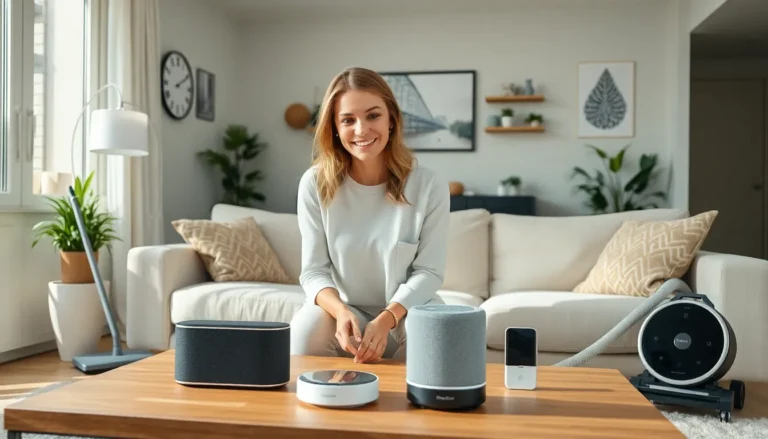In a world where gadgets seem to multiply faster than rabbits, finding the perfect device can feel like searching for a needle in a tech-savvy haystack. With shiny new toys hitting the shelves daily, it’s easy to get caught up in the hype. But hold on! Not all that glitters is gold, and that’s where device critiques come in to save the day—or at least your wallet.
Table of Contents
ToggleOverview of Device Critiques
Device critiques play a vital role in today’s tech landscape. These evaluations help consumers navigate countless gadget options available.
Importance of Device Critiques
Device critiques provide critical insights for prospective buyers. These assessments highlight the features, usability, and performance of various gadgets. Consumers benefit from understanding how devices stack up against each other. Informed choices become easier when users read about real experiences and detailed evaluations. Reviews serve as a trusted source to uncover potential flaws and advantages. With numerous new products launching, critiques guide users toward the best choices based on factual data.
Objectives of This Review
The primary objective of this review focuses on delivering comprehensive evaluations of popular gadgets. Each critique aims to cover specific aspects, such as design, functionality, and user experience. Additionally, the review intends to compare devices across similar categories to highlight strengths and weaknesses. Readers expect transparent analysis, enabling them to make educated decisions. A thorough examination also addresses the price-performance ratio, guiding buyers toward devices that offer the best value.
Key Factors in Device Critiques



In evaluating devices, several key factors contribute to a comprehensive critique. Performance, usability, and design each play crucial roles in guiding consumer decisions.
Performance Evaluation
Performance evaluation examines a device’s speed, efficiency, and overall functionality. Metrics such as processing speed, battery life, and running applications reveal how well the device handles tasks. Benchmarks from independent testing organizations provide definitive comparisons. For instance, a smartphone with a battery lasting over 12 hours typically outperforms competitors with shorter lifespans in practical scenarios. Additionally, graphics performance is critical for gamers, so measuring frame rates during gameplay can indicate a device’s capabilities.
Usability Analysis
Usability analysis focuses on user experience and interaction. Factors like interface intuitiveness, accessibility features, and ease of navigation significantly influence a device’s appeal. Feedback from users highlights common pain points such as complicated setting adjustments or clunky designs. Surveys show that devices with clear, simple interfaces receive higher satisfaction ratings. For example, virtual assistant integration can enhance usability, making it easier for users to perform tasks hands-free. Testing a device in real-world situations offers the best insight into its practical usability.
Design and Aesthetics
Design and aesthetics encompass not only a device’s visual appeal but also its ergonomic functionality. Sleek designs with lightweight materials often enhance user satisfaction. Consumers prioritize build quality, with many preferring metal or durable plastic exteriors that withstand wear and tear. Colors and finishes attract specific demographics, influencing purchasing decisions. Lastly, a well-thought-out layout contributes to usability; button placement and screen size can significantly affect how comfortable a device feels during daily use.
Popular Devices Under Review
Numerous gadgets capture attention in the tech world, especially in the smartphone, laptop, and wearable categories. Comprehensive evaluations help consumers make informed decisions.
Smartphones
Smartphones dominate the market with constant innovation. Key factors like camera quality, battery life, and processing power significantly influence buyer choices. Devices like the latest iPhone and top-tier Samsung Galaxy models frequently receive favorable critiques due to their superior photography and robust app ecosystems. Evaluation metrics often include speed in multitasking and software updates, which can enhance user experience. Real-world testing reveals how well these devices perform under diverse conditions, establishing benchmarks for others.
Laptops
Laptops represent a diverse selection for various user needs, from casual browsing to heavy gaming. Performance reviews focus on factors such as processing speed, graphics performance, and battery duration. Popular models like the MacBook Pro and Dell XPS series consistently get attention for their reliability and design. Usability features like keyboard comfort, screen clarity, and port availability often emerge in critiques. Extensive tests reveal how these devices handle multitasking and productivity applications, allowing consumers to choose based on precise requirements.
Wearables
Wearables gain traction as technology integrates more with daily life. Smartwatches and fitness trackers often top the list for features like heart rate monitoring, GPS accuracy, and app compatibility. Devices such as the Apple Watch and Fitbit models frequently receive high marks for design and functionality. Durability and battery life also play critical roles in user satisfaction. Evaluations assess how well these devices perform during various activities, giving potential buyers clear insights into their day-to-day practicality.
Methodology for Reviews
A systematic approach ensures the critiques of devices remain thorough and reliable. This methodology combines various evaluation criteria and an impartial review process.
Criteria for Evaluation
Evaluation criteria encompass several key aspects. Performance examines processing speed, battery life, and graphics capabilities. Usability focuses on intuitive interfaces and accessibility features that enhance user experience. Design evaluates visual appeal, ergonomic functionality, and build quality, which influence consumer satisfaction. Each device undergoes analysis against these criteria to provide an accurate picture of its strengths and weaknesses. This structured evaluation enables consumers to identify devices that meet their specific needs and preferences.
Review Process
The review process follows distinct steps for consistency and objectivity. Initial research entails gathering essential specifications and user feedback from multiple sources. Testing occurs in realistic scenarios to assess performance and usability effectively. Detailed notes document observations on every tested aspect, ensuring a comprehensive overview. Results are then compiled and analyzed to generate clear, informative ratings for each device. This transparent process enhances trust in the evaluations provided, helping consumers make informed decisions in a competitive market.



